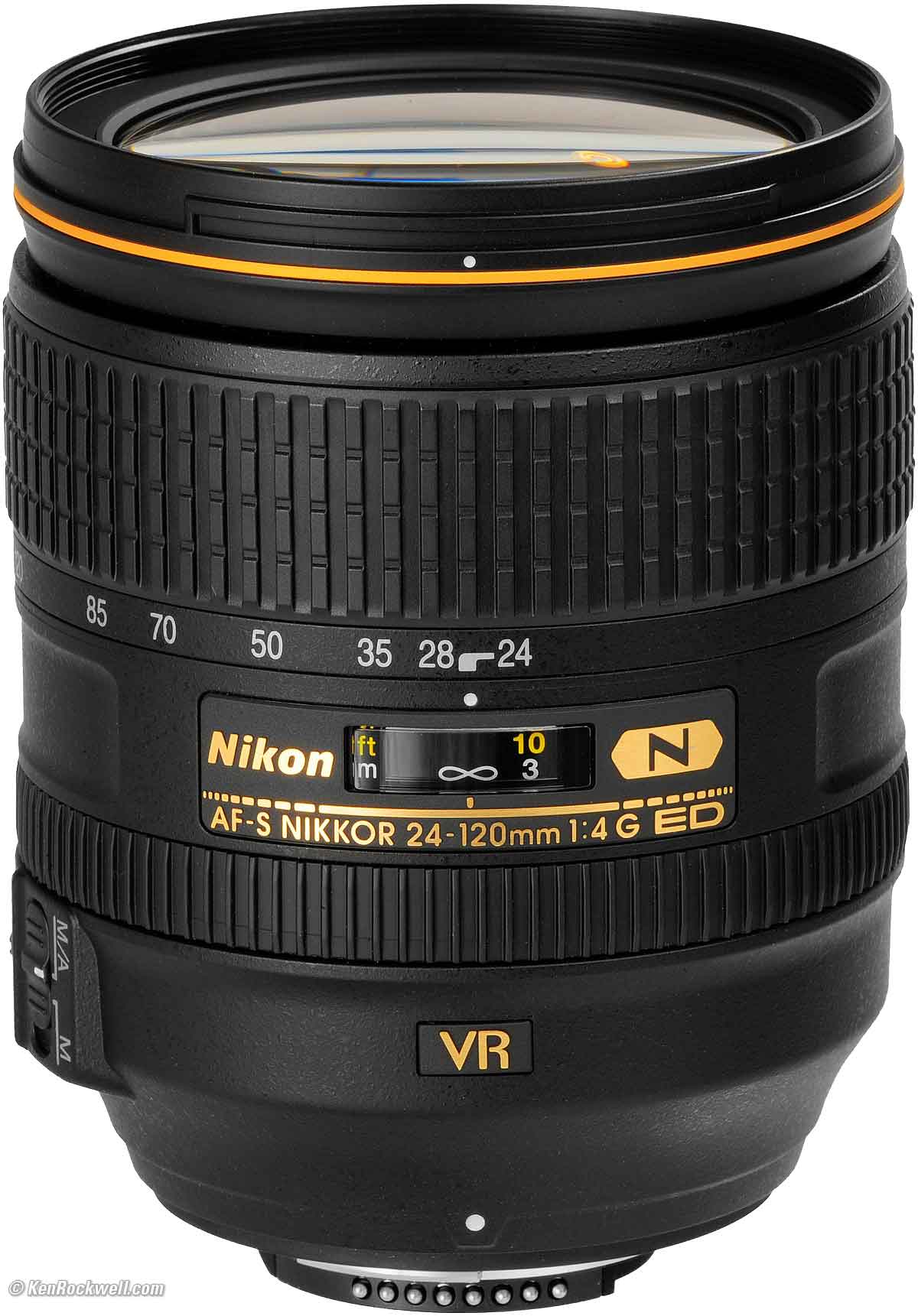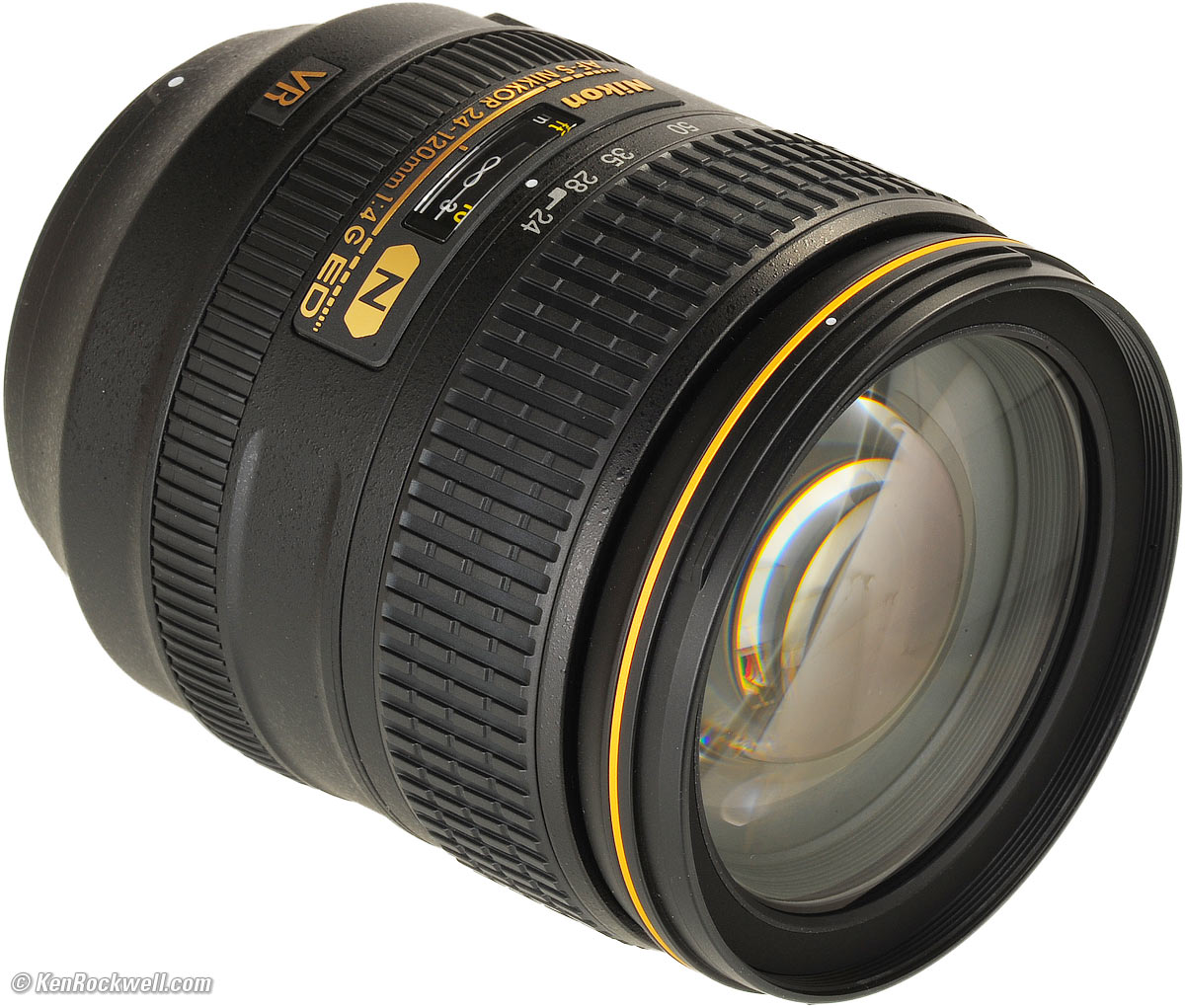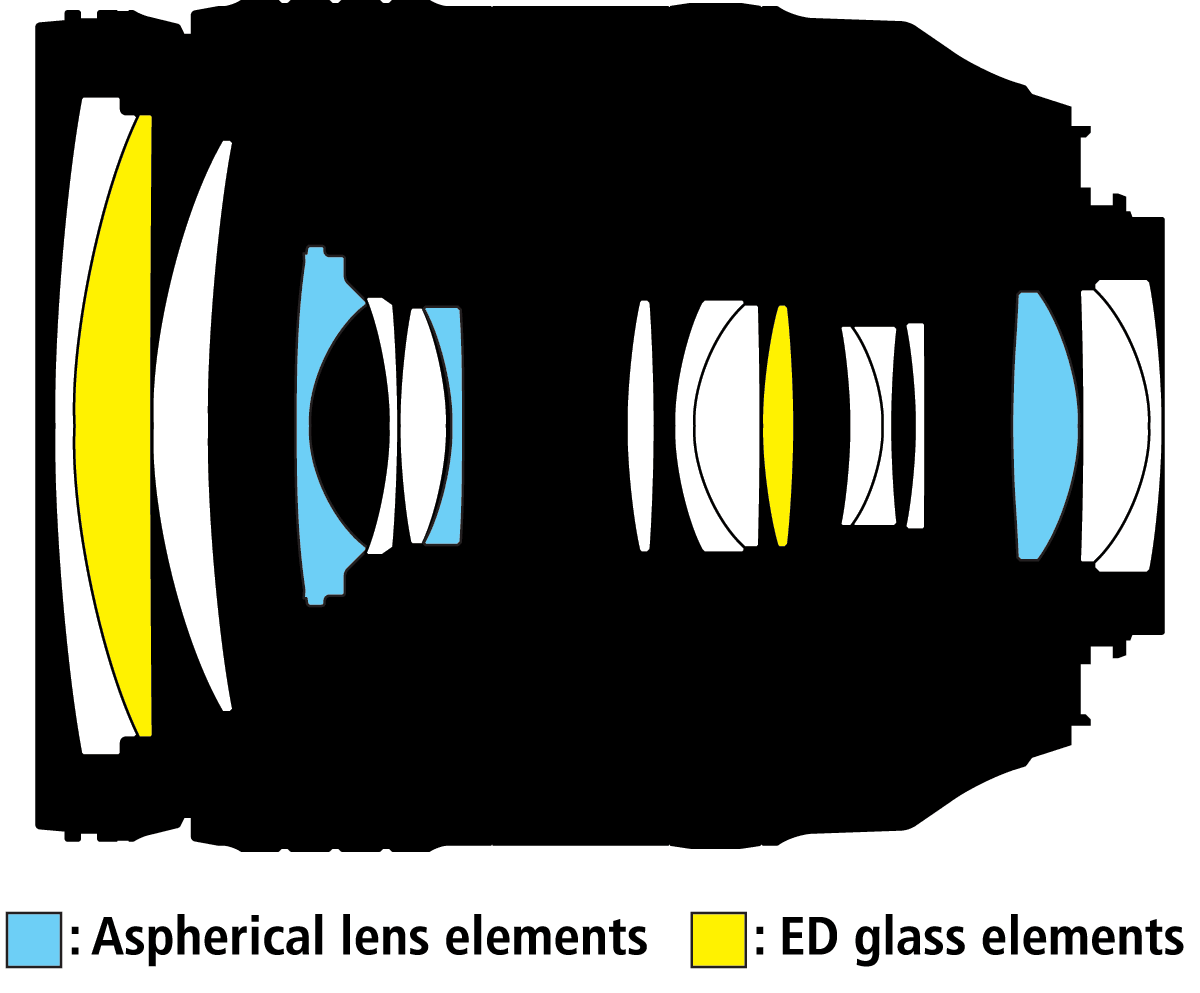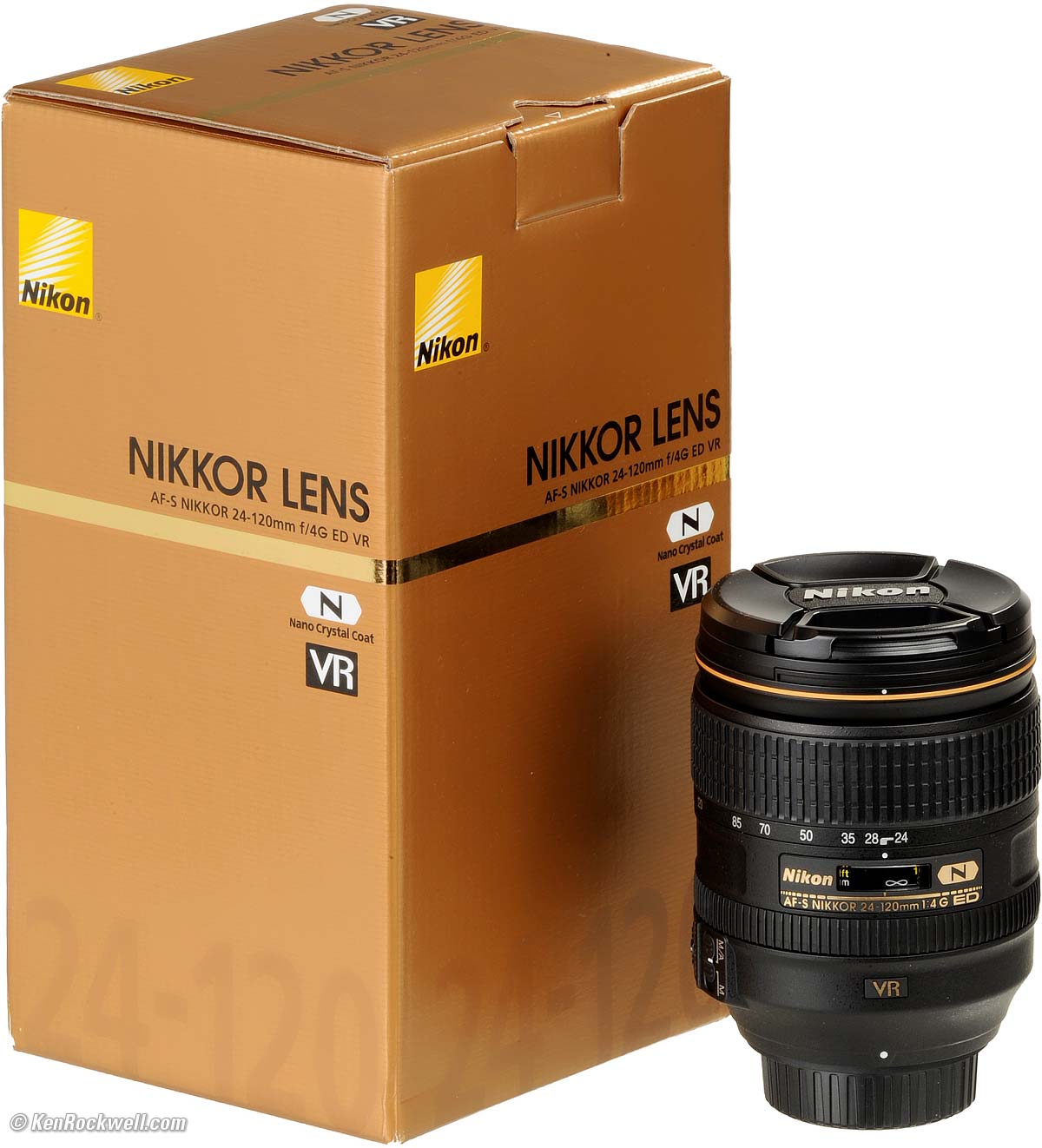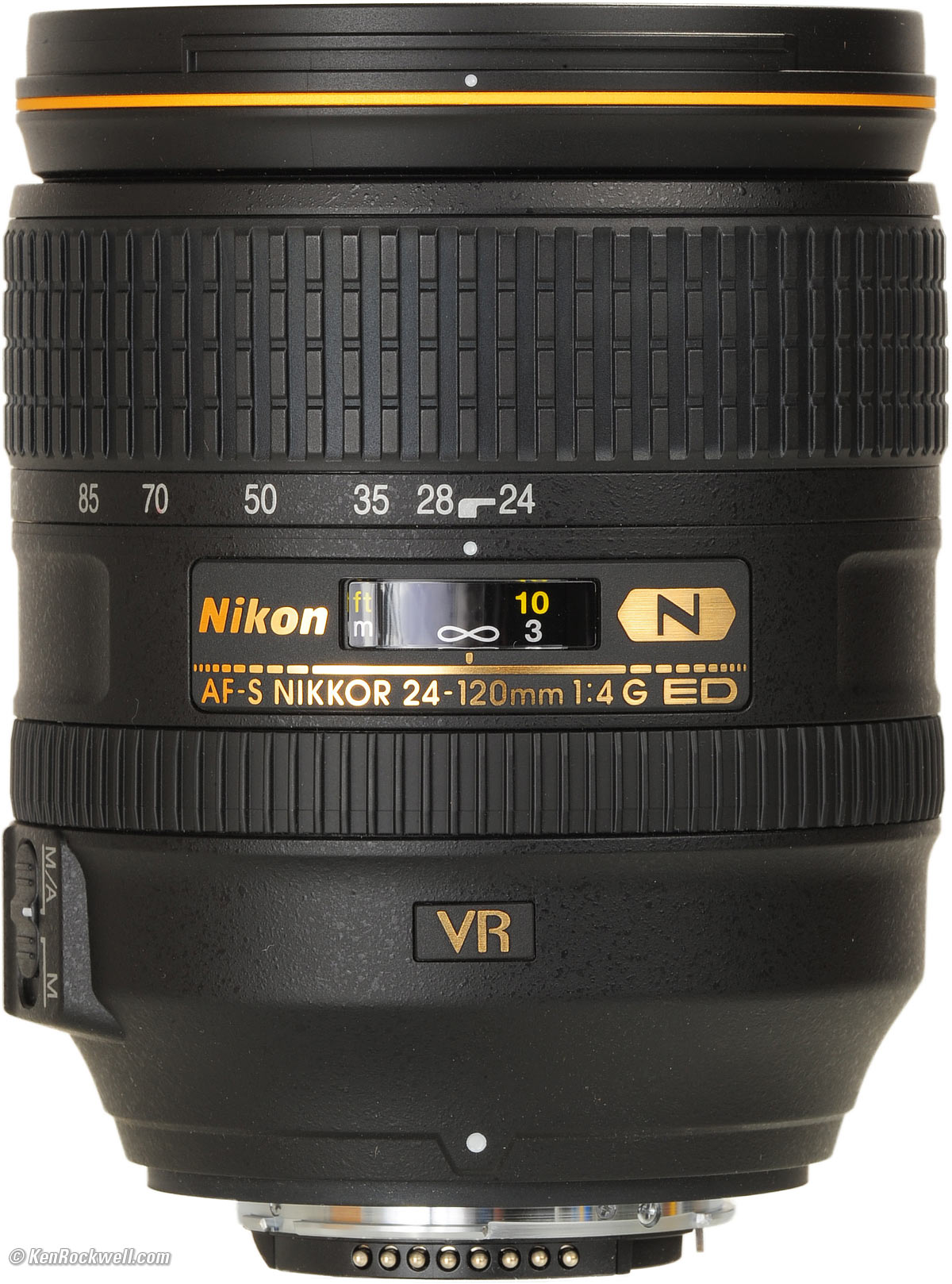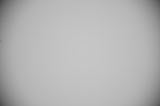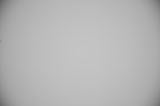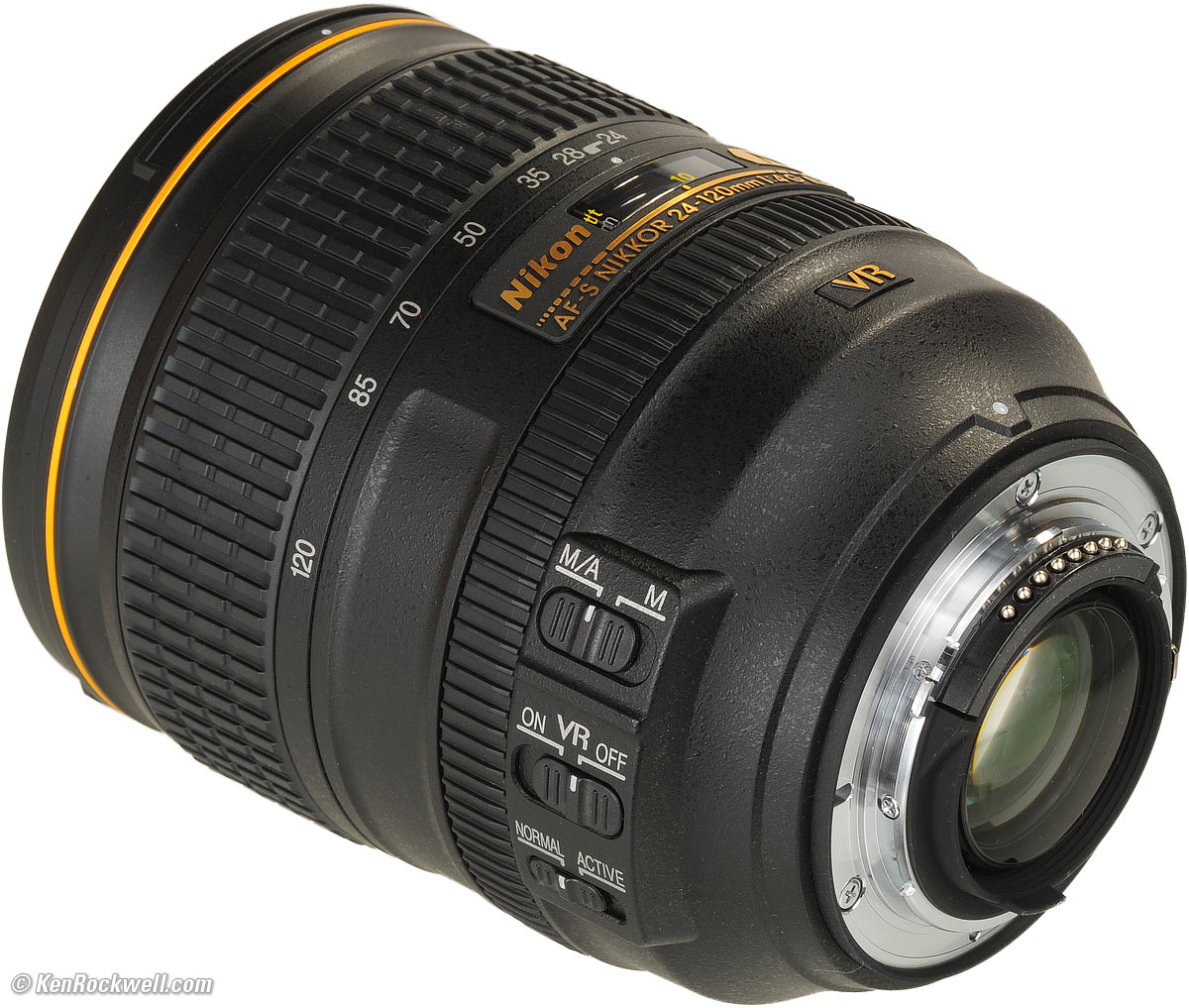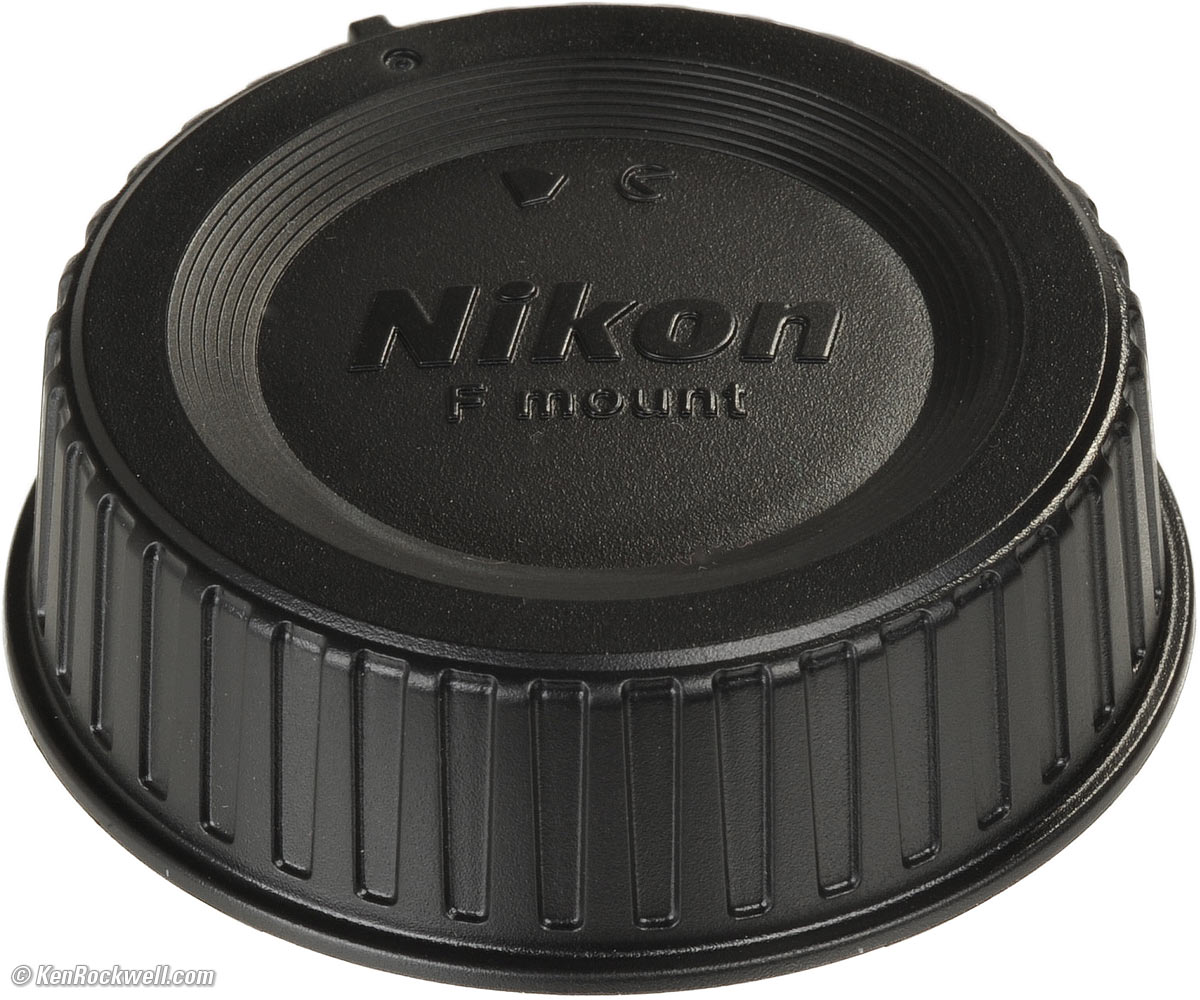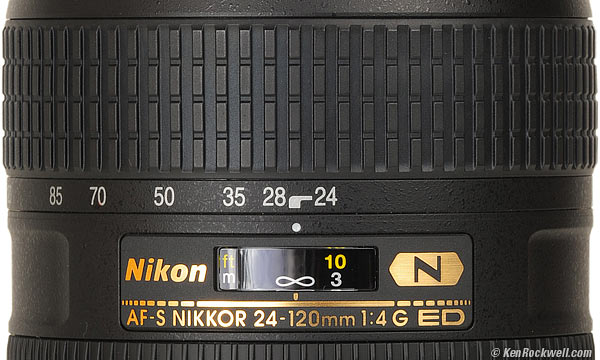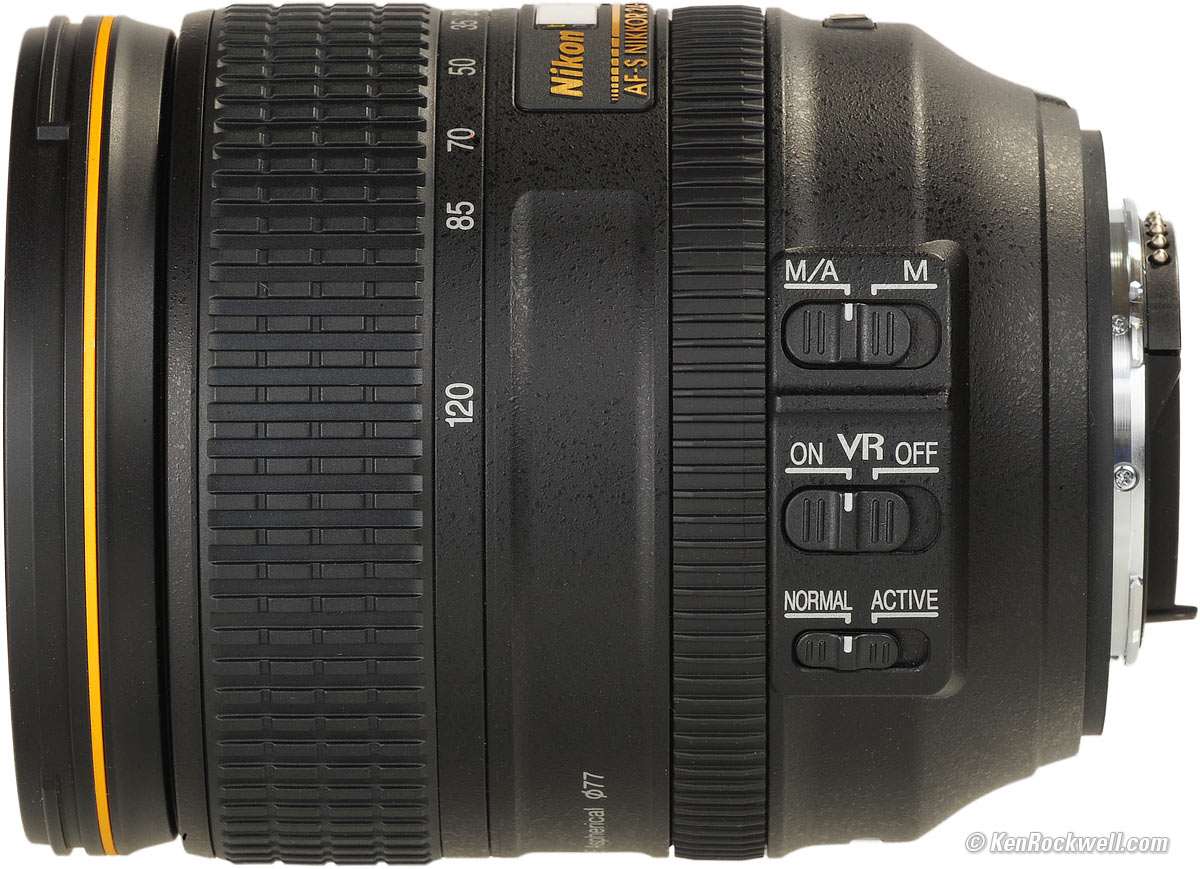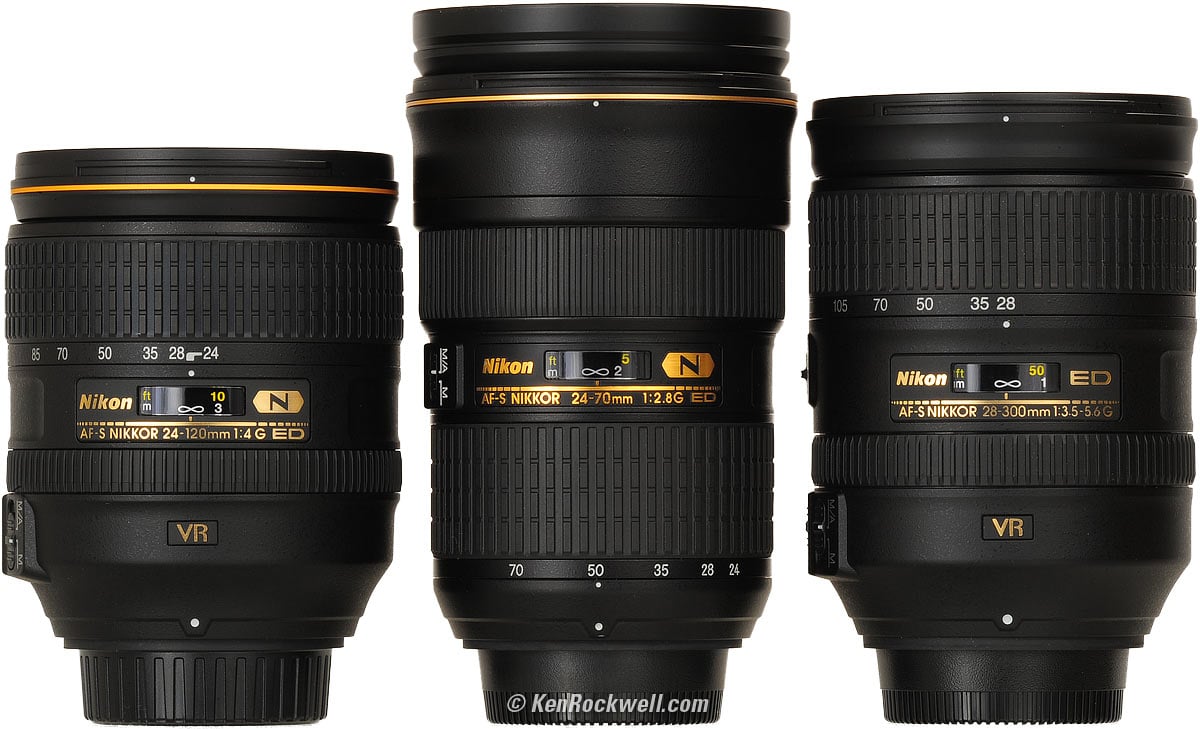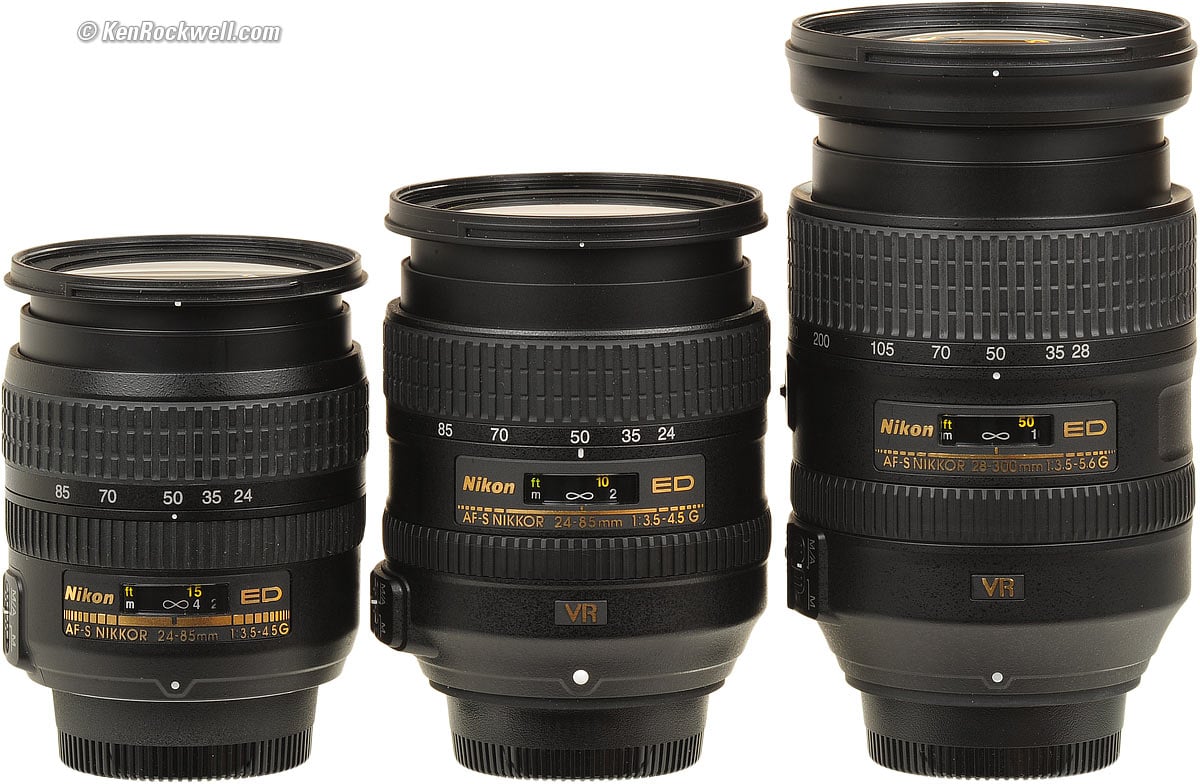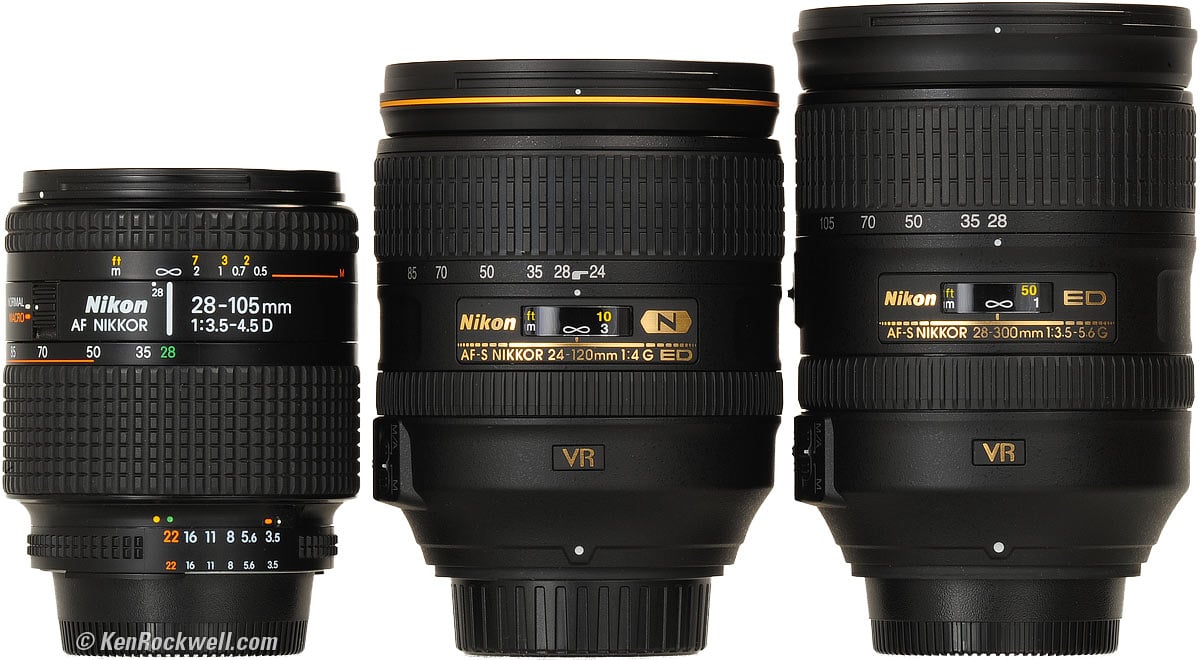Home Donate New Search Gallery Reviews How-To Books Links Workshops About Contact
Nikon 24-120mm f/4 VR
FX G ED AF-S
Intro Specifications Performance Usage Compared Recommendations
Nikon 24-120mm f/4 VR G (77mm filters, 25.0 oz./708g, 1.3 feet/0.40m close focus, about $1,097). enlarge. I got mine at Adorama. I'd also get it at Amazon, at B&H or at Crutchfield. You also can get it used at eBay for about $450 if you know How to Win at eBay.
This all-content, junk-free website's biggest source of support is when you use those or any of these links to my personally-approved sources when you get anything, regardless of the country in which you live. Nikon does not seal its boxes in any way, so never buy at retail or any other source not on my personally approved list since you'll have no way of knowing if you're missing accessories, getting a defective, damaged, returned, non-USA, store demo or used lens. Get yours only from the approved sources I use myself for the best prices, service, return policies and selection. Thanks for helping me help you! Ken.
April 2018 Nikon Reviews Nikon Lenses Nikon Flash All Reviews
Sharpness Comparison to all other 24mm lenses
24-120mm f/3.5-5.6 VR (2003-2010)
24-120mm AF-D (1996-2002)
24-85mm VR (2012-)
Ideal for
Perfect for use as your only lens on FX digital and film.
Not for
I wouldn't bother with this on a DX camera. I'd use a DX lens instead.
Introduction top
Intro Specifications Performance Usage Compared Recommendations
|
I buy only from these approved sources. I can't vouch for ads below. |
This Nikon 24-120mm f/4 VR is a hugely popular lens because it covers an ideal range with high speed, great sharpness, close-focusing, great handling and it's reasonably priced for this level of quality.
Everything works perfectly on every digital Nikon, both FX and DX, and even on Nikon's cheapest digitals like the D40, D40x, D60, D3000, D3100 and D5000.
It's also perfect on decent or recent AF film cameras like the F6, F100, F5, N80 and N75.
The incompatibilities for older or cheaper film cameras are that:
1.) It won't autofocus with the cheapest new AF film cameras like the N55, but if you focus manually, everything else works great. Even if you lose autofocus, these cameras have in-finder focus confirmation dots to help you.
2.) Late 1980s ~ early 1990s AF cameras like the N90s, N70 and F4 will focus just fine, but you'll lose VR. You'll have Program and Shutter-priority modes, but lose Manual and Aperture-priority since you have no way to set the aperture on the camera or on the lens.
3.) You're really pushing it with the oldest AF cameras like the N2020, N6006 and N8008. You'll have no AF, confused exposure modes, and no VR. Manual focus is fine, along with electronic focus indications.
4.) Since it has no aperture ring, it's just about useless with manual focus film cameras.
See Nikon Lens Compatibility for details with your camera. Read down the "AF-S, AF-I," "G" and "VR" columns for this lens. You'll get the least of all the features displayed in all columns, since "G" (gelding) is a handicap which removes features.
Nikon 24-120mm f/4 VR. enlarge.
Nikon's first 24-120mm f/3.5-5.6 AF-D (1996-2002) was nicknamed "The Streetsweeper" by journalists since they could shoot just about anything that was thrown at them on an instant's notice with it. It was a swell lens.
Nikon's next 24-120mm f/3.5-5.6 VR (2003-2010) was awful. It added VR and instant manual-focus override, which was great on paper, but there were two big problems. It had a lot of falloff, which lead to annoyingly dark corners at just about every setting, and it was horribly soft, also at every setting. This horrible optical performance won it a place among Nikons Ten Worst Lenses of All Time.
This new 24-120mm is a huge improvement over the other 24-120s. It retains VR and instant manual-focus override, and adds a full stop of real speed where you need it at 120mm, and is sharp.
Yes, this new lens costs more than twice as much as the old f/3.5-5.6 VR, but the old lens was horrible because it never got sharp, even stopped down.
Specifications top
Intro Specifications Performance Usage Compared Recommendations
Name top
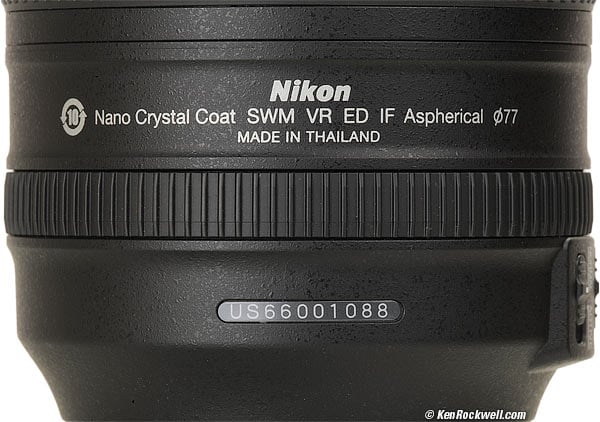
Bottom, Nikon 24-120.
Nikon calls this the Nikon AF-S NIKKOR 24-120mm f/4G ED VR.
AF-S: Silent Wave Autofocus Motor.
NIKKOR: Nikon's brand name for all their lenses.
G: Gelded (no aperture ring) for cost-reduction and removing compatibility with older cameras.
ED: Magic Extra-low Dispersion Glass.
VR: Vibration Reduction.
Nano Crystal Coat (N): Magic anti-reflection coating that has a variable index of refraction that's far more effective against ghosts and internal reflections than traditional multicoating.
IF: Internal focusing; nothing moves externally as focused.
Aspherical: Specially curved glass elements for sharper pictures.
∅77: 77mm filter thread.
Also has:
D: Couples distance information to the Matrix Meter.
Optics top
Internal diagram, Nikon 24-120mm f/4 VR. enlarge.
17 elements in 13 groups.
Internal focusing; nothing moves externally as focused.
Three aspherical elements.
Two ED (magic Extra-low Dispersion glass) elements.
Nikon Super Integrated Coating (SIC).
Coverage top
Diaphragm top
9 rounded blades.
Stops down to f/22.
Focal Length top
24-120mm.
When used on a DX camera, it gives angles of view similar to what a 35-180mm lens gives when used on an FX or 35mm camera.
Angle of View top
84° ~ 20.5° on FX and RealRaw.
61° ~ 13.3° on small-format DX.
Close Focus top
1.3 feet (15-3/4" or 0.40m), measured.
1.5 feet (0.45m).
Maximum Reproduction Ratio top
1:4.2.
Hard Infinity Focus Stop? top
No.
You have to let the AF system focus at infinity.
Focus Scale top
Yes.
Depth-of-Field Scale top
No.
Infra-Red Focus Index top
No.
Aperture Ring top
No.
Filter Thread top
77mm, plastic.
Does not rotate.
Vibration Reduction (VR) top
VR II.
Claims "up to 4 stops" improvement.
Size top
Nikon specifies 3.3" (84mm) diameter by 4.1" (103mm) extension from flange.
Weight top
24.960 oz. (707.6g), measured.
Nikon specifies 23.6 oz. (670g).
Hood top
Plastic bayonet HB- 53 hood, included.
Case top
CL-1218 pouch, included.
Included top
Snap-on front lens cap
Cheaper LF-4 rear cap, not the professional LF-1 as specified.
Plastic bayonet HB- 53 hood
CL-1218 pouch.
Quality top
Made in Thailand.
Announced top
19 August 2010.
Available top
Shipping since the end of September 2010.
Nikon Product Number top
2193.
Price, USA top
$1,097, or about $450 used if you know How to Win at eBay, March 2018.
$1,299.95 list price, USA, August 2010.
Nikon 24-120mm f/4 VR and its box. bigger.
Performance top
Intro Specifications Performance Usage Compared Recommendations
Overall performance top
The 24-120mm f/4 VR is a great lens, doing most things very well in a very practical package.
Focus performance top
AF Speed
AF is reasonably fast, a bit faster than the 28-300mm VR, but not instantaneous, either.
AF Accuracy
AF is always right-on.
Manual Focus
Manual focus is great; just grab the ring at any time.
It's slow at 24mm, and a little fast at 120mm; the best to which a zoom can hope.
M/A - M Switch
Nikon goofed. This switch is supposed to be labeled "A - M."
The "M/A" position means autofocus. It's called "M/A" because you also can focus manually simply by grabbing the focus ring in this position.
The "M/A" position means autofocus. It's called "M/A" because back in the old days, when Nikon had almost caught up to Canon who had been doing this for ten years before, Nikon was trying to show off that you could focus manually while in the AF position.
Paint over the extra M if you're easily confused.
Bokeh performance top
Bokeh, the character of out of focus backgrounds, not simply how far out of focus they are, is reasonably pleasant at the long end, the only place it might matter. Out-of-focus highlights are soft circles.
Distortion performance top
The Nikon 24-120m f/4 VR is loaded with distortion. Luckily most Nikons today let you set them to remove this distortion automatically.
Without correction on FX, it has strong barrel distortion at 24mm, and strong pincushion distortion from 35mm through 120mm. Distortion is minimal at 28mm.
Without correction on DX, it still has a lot of distortion: barrel from 24 - 28mm, and pincushion from 35mm through 120mm.
If shot on film or without correction, this can be corrected for critical use by plugging these figures into Photoshop's lens distortion filter. These aren't facts or specifications, they are the results of my research that requires hours of photography and calculations on the resulting data.
DX at 3m (10') |
||
24mm |
+4.7* |
+3.0 |
28mm |
0.0* |
+1.0 |
35mm |
-3.5 |
-1.0 |
50mm |
-4.2 |
-1.5 |
70mm |
-4.5 |
-2.0 |
85mm |
-4.5 |
-1.5 |
120mm |
-4.0 |
-1.0 |
© 2010 KenRockwell.com. All rights reserved.
* very minor waviness remains.
Ergonomics (handling and ease-of-use) performance top
Nikon 24-120/4 VR. enlarge.
Ergonomics are fine. Focus, zoom, and everything feels great.
Eyeblow performance top
The 24-120mm is a "pumper" zoom, so air pumps in and out as you zoom in and out. You may feel some air blow out of the eyepiece into your eye if you zoom out quickly.
You won't usually care, but the design of the 24-120 VR is such that air, and thus dirt, are pumped in and out all the time through both your lens and your camera. The ass-gasket doesn't matter.
Falloff (darkened corners) performance top
Most Nikons can be set for Vignette Correction, which corrects falloff.
Without correction, falloff on FX is strong at 24mm at large apertures. You'll see it at 24mm at f/4, but that's about it.
Its so strong at 24mm and f/4 you might think you got a defective lens, but they're all this way. Stop down to f/5.6 and it's much less of a problem.
It won't be an issue at all on DX (see crop factor), even without correction.
I've exaggerated this by shooting a gray field and placing these on a gray background.
Nikon 24-120mm f/4 VR falloff on FX and film at infinity, no correction.
© 2010 KenRockwell.com. All rights reserved.
|
Filters, use with performance top
There is no problem with filter vignetting, even with a thick filter.
Don't try two stacked filters at 24mm on FX; you will get some cut-off.
The filter ring pumps forwards and back with zooming, but never rotates.
Focal Lengths, effective performance top
The effective maximum focal length shortens at distances closer than infinity in order to allow this lens to focus as close as it does.
At 7 feet, the 120mm setting is really only about 100mm, effective. It gets even shorter at closer distances. At a couple of feet, the 28-300mm only has slightly more magnification at its 300mm setting, which shortens by an even larger percentage at the same close distances. The 28-300mm gets more magnification at any distance, but not by as great a margin at 2 feet.
Lateral Color Fringes performance top
There are no lateral color fringes on Nikon digital, which corrects them automatically should this lens have any.
Mechanics and Construction performance top
Nikon 24-120mm f/4 VR. enlarge.
The Nikon 24-120/4 VR is made as well as most of Nikon's latest lenses, like the 18-200mm VR and 28-300mm VR. It's all plastic on the outside, and what seems like plastic and metal on the inside.
Filter Threads
Plastic.
Hood
Plastic bayonet.
Hood Mount
Plastic.
Barrel Exterior
Plastic.
Focus Ring
Plastic; rubber covered.
Zoom Ring
Plastic; rubber covered.
Depth-of-Field Scale
None.
Internals
I see both plastic and metal.
Aperture Ring
None.
Mount
Dull-chromed brass.
Markings
Paint.
Identity Plate
Gold-look plastic plate on outside of barrel, just below focus scale window.
Serial Number
Sticker glued into recess on bottom of barrel.
Dust seal at mount
Yes.
Noises When Shaken
Assorted mild clunking.
Made in
Thailand: lens and both caps.
Rear Cap
Nikon LF-4 rear cap. enlarge.
LF-4 rear cap supplied with lens.
Weaknesses
Don't ever bang the front of the lens on anything; you will quite likely break some part of the zoom mechanism.
Sharpness performance top
Warning 1: Image sharpness depends more on you than your lens.
Warning 2: Lens sharpness doesn't mean much to good photographers.
With those caveats, the Nikon 24-120/4 is quite sharp. It's a bit softer on the sides and corners at f/4, but so what: it's still quite good, and in the conditions under which you'd be shooting at f/4, it's unlikely you'd have anything in focus in the corners as well as in the center at the same time.
It is as sharp as the 28-300 VR.
When Nikon makes a great lens it's easy to review: it's sharp.
Nikon's claimed MTF curves:
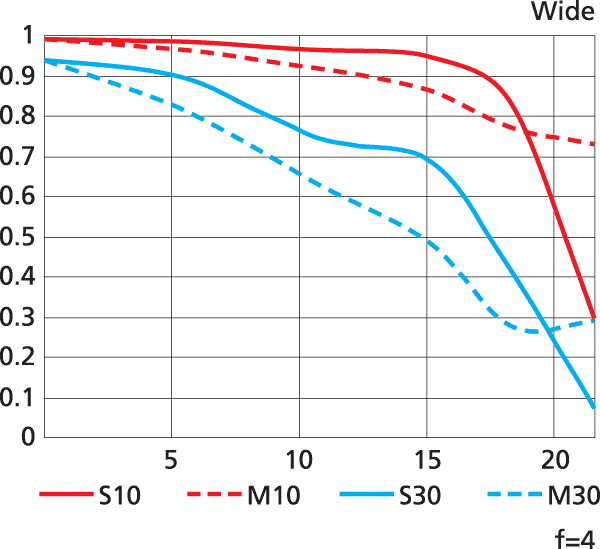
MTF at 24mm.
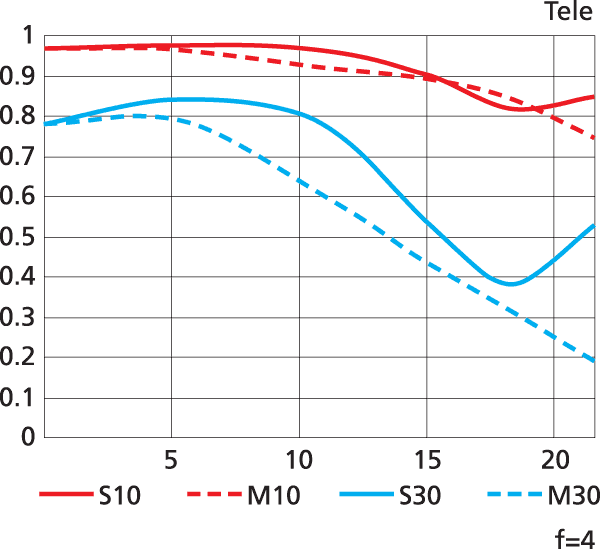
MTF at 120mm.
These MTF curves are much better than MTF curves of the old, nasty 24-120mm f/3.5-5.6 VR (at 24mm and at 120mm).
Sunstars performance top
With its largely rounded diaphragm, I haven't been able to get any sunstars out of it.
For good sunstars, use an older lens with a more conventional diaphragm. The 9 straight blades of the 28-70mm f/3.5-4.5 make exquisite sunstars.
Survivability performance top
The Nikon 24-120/4 VR is a consumer lens. I doubt that any sample made today will endure 20 years of constant use without needing repair, as can Nikon's professional lenses like the 80-200mm f/2.8 AF-D.
This 24-120 has a lot of plastic in it, and depends on the internal motor to focus the lens, not a motor in the camera. Likewise, hit the front of the lens on anything, and you'll probably take out the zoom mechanism.
It will last for years under the kind of use for which its designed, but I don't know that this lens has any destiny as a classic in 20 years, especially if used professionally on a daily basis.
Zooming performance top
It zooms well, but it is a little crowded at the wide end.
Zoom ring, Nikon 24-120mm f/4 VR. enlarge.
Usage top
Intro Specifications Performance Usage Compared Recommendations
Controls, Nikon 24-120mm f/4 VR. enlarge.
Focus
Leave it on M/A.
Only set it to M if you want to disable autofocus.
Vibration Reduction (VR)
Leave it ON, unless you're on a tripod.
Leave it at NORMAL, unless you're shooting from a moving platform.
Compared top
Intro Specifications Performance Usage Compared Recommendations
24-120 f/4 VR |
||||||
| Anni | 2010- |
2010- |
2012- |
1998-2006 |
2003-2010 |
1996-2002 |
| Maximum Aperture | f/4 |
f/3.5-5.6 |
f/3.5-4.5 |
f/3.5-4.5 |
f/3.5-5.6 |
f/3.5-5.6 |
| Filter | 77mm |
77mm |
72mm |
62mm |
72mm |
72mm |
| Close Focus* | 1.3'/0.40m |
1.5'/0.45m |
1.25'/0.38m |
0.7'/0.22m |
1.6'/0.5m |
1.5'/0.5m |
| Max Repro Ratio | 1:4.2 |
1:3.2 |
1:4.5 |
1:2 |
1:4.8 |
1:4.8 |
| Sharpness | Very Good |
Very Good |
Very Good |
Very Good |
Horrid |
Good enough |
| Distortion | Heinous |
Heinous |
Heinous |
Minor |
Heinous |
|
| Instant manual-focus override? | Yes |
Yes |
Yes |
No |
Yes |
no |
| Diaphragm | 9 |
9 |
7 |
9 |
7 |
7 |
| Weight* | 708g |
796g |
460g |
450g |
568g |
560g |
| Price, 10/2010 | n/a |
|||||
| Price, 12/2012 | ||||||
| Price, 3/2018 |
* Actual measured values.
Versus the 28-300mm VR FX
Nikon 24-120mm f/4 VR and 28-300mm VR. enlarge.
Get the 28-300mm VR. I did. I bought both of these, and sent back the 24-120mm as redundant. The 28-300mm VR is as good, and goes all the way to 300mm, for less money.
The 28-300mm VR was announced on the same day, costs less and does more. I prefer my 28-300mm over the 24-120mm because of the much longer zoom range. They are equally as sharp. While the 24-120 weighs a little less, I'd have to carry a second telephoto zoom with it, so the 28-300mm wins again. I don't find any value in the slightly faster speed at 120mm (f/4 vs f/5.4) or the slightly wider 24mm versus 28mm wide end, and I find a huge value in $150 more in my pocket and a two-and-a-half times longer zoom range in my 28-300mm. Personally I think Nikon dresses-up the 24-120 to make a lot more profit selling you less lens for more money.
This new 24-120 is a great lens, but the 28-300mm VR goes 2.5 times longer, with little increase in size or weight, for less money.
The only two things the 24-120 does slightly better is go to 24mm, instead of 28mm, and add about a half stop more speed. Even at 120mm, there is less than one stop speed advantage to the 24-120mm, and at 28mm, the 28-300mm is faster. 24mm is about the same as 28mm. In fact, 24mm is so much the same as 28mm that Nikon can't even fit "24" close enough to "28" on the zoom ring, and instead has to use a line pointing to where it ought to be:
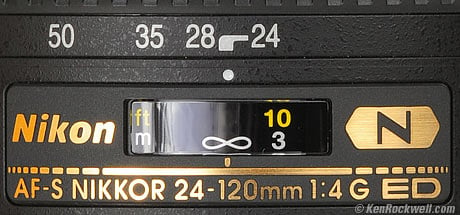
Zoom ring at 24mm.
If you anticipate a few situations where you might need the slightly wider angle of the 24-120mm, I'd still get the 28-300mm VR instead and use the money saved to buy a used 18mm f/3.5 AI-s or 20mm f/2.8 AI-s, either of which are far wider and have less distortion than any of these zooms. For even less money, you could buy a used 20mm f/4 or 20mm f/3.5, along with the 28-300mm VR, and still spend less for the two lenses than just the 24-120mm f/4 VR alone!
If you think you might need a faster lens at the long range, the half-stop extra of the 24-120 is meaningless: the 28-300 is f/5.6 at 300mm, but at 50mm, it's f/4.5. If you really need faster in the tele range, use the $270 you saved buying the 28-300mm to buy a used 85mm f/1.8 AF-D over eBay (here's a direct link to the 85/1.8 at eBay), and you'll be way ahead of the 24-120mm for speed and performance.
Both lenses are made with the same quality and materials in Thailand. They look the same.
Both lenses use ED glass, but only the 24-120 bothers to use gold trim. The gold trim for the 28-300mm ED was put on the non-ED 85mm f/1.4 AF-S instead by mistake. (The exterior styling has nothing to do with what's inside.)
Both lenses have instant manual-focus override.
The 24-120mm is about the same size and weight as the 28-300mm VR. Both have the same mechanical, optical and ergonomic quality. The gold "ED" band on the 24-120mm has been left off the 28-300mm in the interest of discretion when the 28-300mm is used by investigators; both lenses are ED.
The "N" nano-crystal coating of the 24-120mm is marketing baloney; the old 24-120 VR had no problem with flare, nor does the 28-300mm.
They both have the same strong distortion.
They are just as sharp as each other, which is pretty sharp. How do I know? I purchased one of each from Adorama, and shot them against each other at the range. The two images are usually indistinguishable, but depending on the test conditions for each frame, one will be slightly better or worse than the other. Neither is better or worse than the other overall.
If you need optical quality better than the 28-300mm, the 24-120mm isn't any better. You'll have to step up to Nikon's extraordinary 24-70mm f/2.8 AF-S ED G N or the 24-70 VR:
24-120 f/4, 24-70mm f/2.8 and 28-300mm VR. enlarge.
Versus 24-85mm VR FX
The newer 24-85mm VR does pretty much the same thing with less weight and for less than half the price, if you don't mind losing 50% from the telephoto range. If you are going to carry a telephoto zoom along with the 24-120 or 24-85, the 24-85 is a great choice.
Versus older 24-120mm lenses
The previous 24-120mm f/3.5-5.6 AF-S VR (2003-2010) was horribly soft. Either of these 24-120 AF-S VR lenses are much better ergonomically than their even older predecessor, the clunky 24-120mm AF-D (1996-2002).
What about the 24-85mm lenses?
Nikon 24-85mm AF-S G, 24-85mm VR and 28-300mm VR. enlarge.
I'd forget the 24-85mm f/2.8-4 AF-D, sold today and introduced in 2000. It was never very sharp, even on film, even though it has a great 9-bladed diaphragm and works on manual-focus 35mm cameras.
The original 24-85mm AF-S G (2002-2006) is a thoroughly modern lens, with astounding identical optical performance, but lacking VR. It's as sharp as this 24-120 VR and made as well, complete with ED glass and AF-S instant manual-focus override.
The 28-300mm VR is bigger and heavier but less expensive and just as sharp.
Avoid the earlier 24-120mm f/3.5-5.6 VR, it's a dog optically.
The 16-85mm VR is a great lens, but only for DX, not FX.
| Anni | 2012- |
2002-2006 |
2000- |
2010- |
2010- |
| Filter size | 72mm |
67mm |
72mm |
77mm |
77mm |
| AF type | AF-S |
AF-S |
screw |
AF-S |
AF-S |
| Instant manual-focus override? | Yes |
Yes |
no |
Yes |
Yes |
| Close focus | 1.25' 0.38m |
1.2' 0.38m |
0.5' 0.21m |
1.3' 0.4m |
1.6' 0.5m |
| Max. repro ratio | 1:4.5 |
1:4.7 |
1:2 |
1:4.2 |
1:3.2 |
| Sharpness | Excellent |
fair |
|||
| Distortion | Heinous |
Heinous |
|||
| Weight | 16.2 oz. 460 g |
14.5 oz. 412 g |
19 oz. 545 g |
25.0 oz. 708 g |
28.1 oz. 796 g |
| Price, 7/2012 | $300 used |
||||
| Price, 3/2018 | $300 used |
Versus the really old 28-105mm AF-D
Nikon 28-105 AF-D, 24-120 AF-S and 28-300mm VR. enlarge.
If price, size or distortion matters, the Nikon 28-105 AF-D (1998-2006) covers almost the same zoom range as the 24-120mm, but does it without distortion, focuses much closer with an additional macro range absent in the other lenses, and weighs and costs much less. Disadvantages are less sharpness at 105mm, balky manual focus and no VR.
Recommendations top
Intro Specifications Performance Usage Compared Recommendations
This 24-120mm is an extremely popular FX lens for all the right reasons. While I prefer the 28-300mm VR, if you think you'd like this ens, you'll love it.
This is a great lens or use on FX and 35mm cameras. While it works great on DX, it's much bigger and more expensive than you need since you're paying this premium to cover a larger sensor that DX cameras don't have. For DX, get a DX lens like the 18-140mm VR DX which does more for less on DX.
I got mine at Adorama. I'd also get it at Amazon, at B&H or at Crutchfield. You also can get it used at eBay for about $450 if you know How to Win at eBay.
This all-content, junk-free website's biggest source of support is when you use those or any of these links to my personally-approved sources when you get anything, regardless of the country in which you live. Nikon does not seal its boxes in any way, so never buy at retail or any other source not on my personally approved list since you'll have no way of knowing if you're missing accessories, getting a defective, damaged, returned, non-USA, store demo or used lens. Get yours only from the approved sources I use myself for the best prices, service, return policies and selection. Thanks for helping me help you! Ken.
I use a clear (UV) protective filter instead of a cap. I only use a cap when I throw this in my bag, otherwise I leave a clear filter on my lens at all times.
The best protective filter is the 77mm Hoya multicoated HD3 UV which uses hardened glass and repels dirt and fingerprints.
For less money, the B+W 77mm 010 is an excellent filter, as is the multicoated version and the basic multicoated Hoya filters or the 77mm Nikon Clear (NC - UV), but the Hoya HD3 is the toughest and the best.
Filters last a lifetime, so you may as well get the best. The Hoya HD3 stays cleaner than the others since it repels oil and dirt, and will outlast this lens.
For color slides like Fuji Velvia 50, I use a 77mm Nikon A2 or 77mm Hoya HMC 81A outdoors.
For B&W film outdoors, I'd use a 77mm Nikon Y48 or O56 filter, or a 77mm Hoya HMC Yellow K2 or 77mm B+W Orange. Use a yellow filter for normal results outdoors on B&W, and I prefer the orange for stronger clouds. If you use no filter the skies and clouds will be washed-out because B&W film is overly sensitive to blue and ultra-violet light; a yellow filter gives a natural rendition.
More Information
© Ken Rockwell. All rights reserved. Tous droits réservés. Alle Rechte vorbehalten.
Help Me Help You
I support my growing family through this website, as crazy as it might seem.
The biggest help is when you use any of these links when you get anything. It costs you nothing, and is this site's, and thus my family's, biggest source of support. These places always have the best prices and service, which is why I've used them since before this website existed. I recommend them all personally.
If you find this page as helpful as a book you might have had to buy or a workshop you may have had to take, feel free to help me continue helping everyone.
If you've gotten your gear through one of my links or helped otherwise, you're family. It's great people like you who allow me to keep adding to this site full-time. Thanks!
If you haven't helped yet, please do, and consider helping me with a gift of $5.00.
As this page is copyrighted and formally registered, it is unlawful to make copies, especially in the form of printouts for personal use. If you wish to make a printout for personal use, you are granted one-time permission only if you PayPal me $5.00 per printout or part thereof. Thank you!
Thanks for reading!
Mr. & Mrs. Ken Rockwell, Ryan and Katie.

